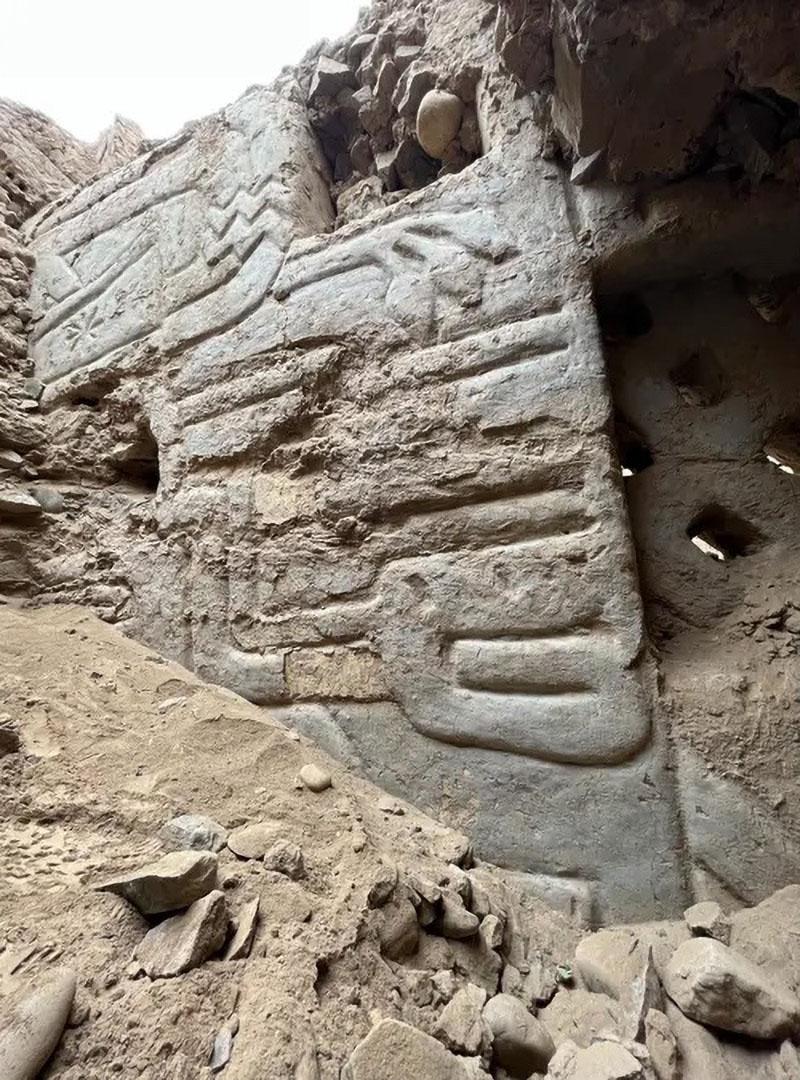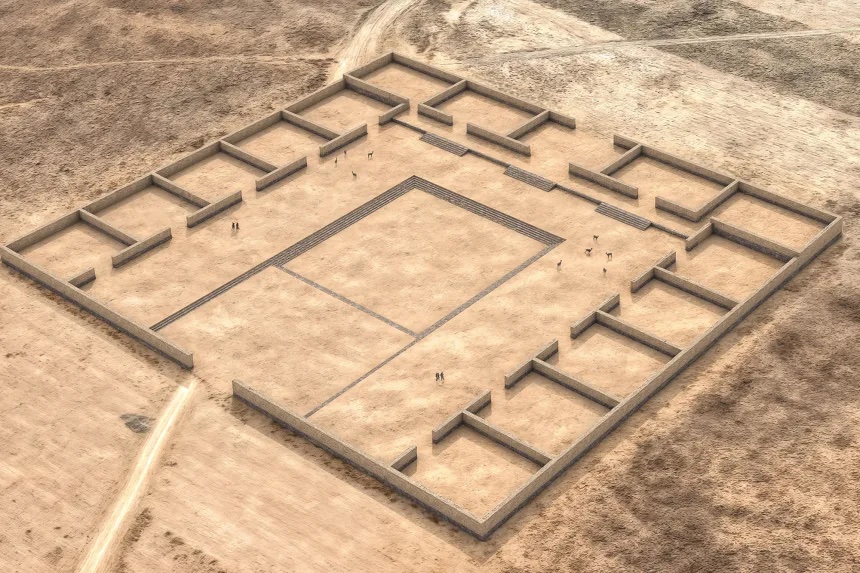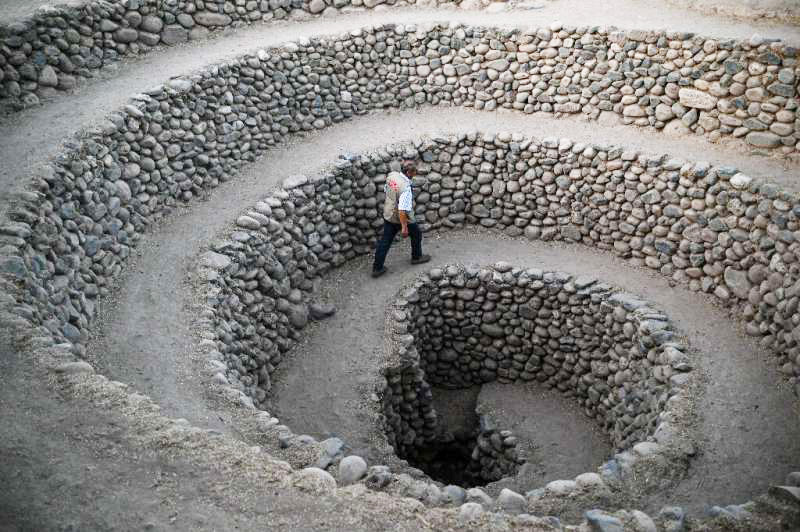
A truly unprecedented discovery': 3,000-year-old pre-incan multicolored mural (petroglyph) with fish, stars and gods discovered in Peru Live Science - August 29, 2025


A multicolored mural (petroglyph) discovered in Peru is shedding light on pre-Inca coastal artistic traditions. Archaeologists have uncovered a massive 3D mural on the northwest coast of Peru. Blue, yellow, red and black paints still adorn the 3,000-year-old mural, which is decorated with fish, stars and mythological beings.
Depicted are three flowers (creation in 3D - Flower of Life Geometry). "They came from the stars. They went into the water (flow of the collective unconsciousness or grid matrixes) to create humans and other sentient life forms - with a promise of protection and to return one day - meaning at the end of the experiment." Time's up!
Anunnaki God Depiction - Holding Flowers - Wrist Device

Enki stands in his watery home the Apsu - primordial freshwater ocean.

One God. Many roles. Male and Female.
Ancient temple could reveal secrets of a lost society that predates the Inca Empire CNN - August 19, 2025

The newly discovered temple complex is located southeast of Lake Titicaca, a region where previous Tiwanaku researchers hadn't focused search efforts
Penguin Vessel: 1,600-year-old Nazca depiction of a cold-water Humboldt penguin that lives in tropical Peru Live Science - July 7, 2025

A rare penguin-shaped pot reveals the Nazca's interest in depicting the wildlife around them.
Huge Ancient Inca Underground Labyrinth Discovered Beneath Cusco, Starting At Sun Temple IFL Science - January 14, 2025

After centuries of rumor and speculation, archaeologists have finally confirmed the existence of a colossal underground tunnel system beneath the Peruvian city of Cusco. Built by the ancient Inca, the labyrinth - or Chincana - radiates outwards from the Temple of the Sun, extending for more than a mile towards a fortress on the edge of the city.
Pre-Hispanic aqueducts irrigate modern Peruvian crops PhysOrg - May 25, 2023

Built some 1,700 years ago by the pre-Hispanic Nazca people of Peru, an ingenious aqueduct system of wood and stone still provides farmers with water to this day.
Inca Ritual Baths Fed by Waterfall Reveals More of Its Secrets Live Science - February 22, 2019
Deep in Peru's Sacred Valley, a ceremonial Inca complex - complete with a stone altar and 14 baths sits in a jungle clearing. And now, cutting-edge radar and laser scans, and on-the-ground excavations are revealing just how the Inca built and used these structures more than 500 years ago. The excavation is a thorough one; ground-penetrating radar detected the foundations of the complex, and billions of laser scans shot from an airborne drone revealed two previously unknown Inca structures hidden in the tropical forest.
19 humanlike wooden idols, 750-Year-Old, Some Wearing Masks, Uncovered in Peru Live Science - October 27, 2018

Archaeologists have discovered 19 humanlike wooden idols, some of them wearing beige clay masks on their faces, in the ancient city of Chan Chan, Peru. The more than 750-year-old hand-carved idols stand nearly 28 inches (70 centimeters) tall, or about the height of two bowling-ball pins stacked on top of one another. The idols were discovered in rectangular recesses that line an adobe-made corridor. These idols are the oldest yet to be discovered at the Chan Chan archaeological complex in northern Peru, which was once the capital of the Chimú Kingdom, a culture that lasted from about A.D. 900 to 1430, when it fell to the Inca Empire.
Drone survey reveals dozens of previously undiscovered Nazca Lines depicting warriors and animals carved into Peru's landscape 1,800 years ago Daily Mail - April 7, 2018

Archaeologists have discovered more than 50 mysterious new 'Nazca lines' in Peru, which were constructed nearly 2,000 years ago by ancient inhabitants who painstakingly arranged pebbles into massive shapes. Some are hundreds of years older than the most famous Nazca lines previously discovered. The researchers learned that while some of the geoglyphs were produced by Nazca people, others date back to a time before they lived in the region where the drawings can be found. The Nazca people lived in the area from 200 to 700 CE. Some of the designs are believed to be created instead by the Topara and Paracas people.
Ring-Shaped Geoglyphs Found Near Ancient Town in Peru Live Science - September 23, 2016
Dozens of circular geoglyphs, some comprising several intertwined rings, have been identified and mapped near the ancient Peruvian town of Quilcapampa, revealing that these earthen designs were created near ancient pathways used for trade. Geoglyphs are designs, which often form shapes or images, on the landscape. They are found all over the world; the most famous examples are located at Nazca, where thousands of such designs - from real and imaginary creatures to geometric shapes - have been etched into the Peruvian desert. The newly mapped geoglyphs may have had symbolic significance, possibly representing the flow of people and goods through the town at the time.
Sechin Bajo, Peru: The Location of the Oldest Man-Made Structure of the New World? Ancient Origins - May 8, 2016
Sechin Bajo is an archaeological site in Peru. This site is situated in the Casma Valley of Ancash, a region on the northwestern coast of that South American country. This site is believed to have served as the capital of a pre-Incan culture, and was occupied roughly between 1800 and 1900 BC.
Inca Road: The ancient highway that created an empire BBC - July 2, 2015
Do long-dead builders have the answer to more sustainable road development? A new exhibit at the Smithsonian Institution in Washington DC shows why the Incan kingdom built a lasting infrastructure. The Inca Road is one of the most extraordinary feats of engineering in the world. By the 16th Century it had helped transform a tiny kingdom into the largest empire in the Western hemisphere. And to the envy of modern engineers, substantial parts of the 24,000-mile (39,000-km) network survive today, linking hundreds of communities throughout Argentina, Bolivia, Chile, Colombia, Ecuador and Peru. Incredibly, it was constructed entirely by hand, without iron or wheeled transportation.
Ancient cranial surgery: bioarchaeologist studies trepanation PhysOrg - December 20, 2013
Some 900 years ago, a Peruvian healer used a hand drill to make dozens of small holes in a patient's skull. Cranial surgery is tricky business, even under 21st-century conditions (think aseptic environment, specialized surgical instruments and copious amounts of pain medication both during and afterward). However, evidence shows that healers in Peru practiced trepanation—a surgical procedure that involves removing a section of the cranial vault using a hand drill or a scraping tool more than 1,000 years ago to treat a variety of ailments, from head injuries to heartsickness. And they did so without the benefit of the aforementioned medical advances. Excavating burial caves in the south-central Andean province of Andahuaylas in Peru, UC Santa Barbara bioarchaeologist Danielle Kurin and her research team unearthed the remains of 32 individuals that date back to the Late Intermediate Period (ca. AD 1000-1250). Among them, 45 separate trepanation procedures were in evidence.
Developers destroy ancient Peru pyramid BBC - July 4, 2013
Authorities in Peru say an ancient pyramid at the oldest archaeological site near the capital, Lima, has been destroyed. They are pressing criminal charges against two real-estate companies blamed for tearing down the structure, which was 6m (20-ft) high. An archaeologist said those responsible had committed "irreparable damage". The building was one of 12 pyramids found at the El Paraiso complex and is thought to be at least 4,000 years old. The site, which dates back to the Late Preceramic (3500-1800 BC) period, is situated several kilometres north of Lima. According to Peru's tourism ministry, it was a religious and administrative centre long before the pre-Columbian Inca civilization.
Stunning Astronomical Alignment Found at Peru Pyramid Live Science - May 6, 2013
An ancient astronomical alignment in southern Peru has been discovered by researchers between a pyramid, two stone lines and the setting sun during the winter solstice. During the solstice, hundreds of years ago, the three would have lined up to frame the pyramid in light. The two stone lines, called geoglyphs, are located about 1.2 miles (2 kilometers) east-southeast from the pyramid. They run for about 1,640 feet (500 meters), and researchers say the lines were "positioned in such a way as to frame the pyramid as one descended down the valley from the highlands."
Archaeologists have discovered a pyramid in southern Peru, built between 600 B.C. and 50 B.C. ago, would have aligned with two stone lines and the setting sun during the winter solstice. Here, a 3D model shows the event that happened at the Cerro del Gentil pyramid during the winter solstice. The two stone lines frame the pyramid with the sun setting directly behind it. This alignment may have had cosmological significance for the people who lived there. An ancient astronomical alignment in southern Peru has been discovered by researchers between a pyramid, two stone lines and the setting sun during the winter solstice. During the solstice, hundreds of years ago, the three would have lined up to frame the pyramid in light. The two stone lines, called geoglyphs, are located about 1.2 miles (2 kilometers) east-southeast from the pyramid. They run for about 1,640 feet (500 meters), and researchers say the lines were "positioned in such a way as to frame the pyramid as one descended down the valley from the highlands." Using astronomical software and 3D modeling, the researchers determined that a remarkable event would have occurred during the time of the winter solstice. "When viewed in 3D models, these lines appear to converge at a point beyond the horizon and frame not only the site of Cerro del Gentil where the pyramid is, but also the setting sun during the time of the winter solstice," the research team wrote in a poster presentation given recently at the Society for American Archaeology annual meeting in Honolulu.
Human Trophy Heads Were No Strangers Live Science - January 5, 2009
The ancient South American people who created the mysterious Nazca Lines - enormous etched images of everything from hummingbirds to orcas on the high Nazca Desert in Peru some 1,500 to 2,000 years ago, also happened to be regular collectors of human heads. Scientists have long wondered if the heads, suspended from woven cords as trophies, came from enemy cultures as the spoils of war, were used in fertility ceremonies, or had some other purpose.
Trophy heads reveal secrets about ancient South American Nazca civilization PhysOrg - January 8, 2009
The Nasca civilization is perhaps best known for the drawings its people etched onto the desert floor in southwest Peru, a massive and mysterious body of simple and intricate works that span several hundred square miles.
Archaeologist 'Strikes Gold' With Finds Of Ancient Nasca Iron Ore Mine In Peru Science Daily - February 5, 2008
A Purdue University archaeologist discovered an intact ancient iron ore mine in South America that shows how civilizations before the Inca Empire were mining this valuable ore. "Archaeologists know people in the Old and New worlds have mined minerals for thousands and thousands of years," said Kevin J. Vaughn, an assistant professor of anthropology who studies the Nasca civilization, which existed from A.D. 1 to A.D. 750. "Iron mining in the Old World, specifically in Africa, goes back 40,000 years. And we know the ancient people in Mexico, Central America and North America were mining for various materials. There isn't much evidence for these types of mines.
"What we found is the only hematite mine, a type of iron also known as ochre, recorded in South America prior to the Spanish conquest. This discovery demonstrates that iron ores were important to ancient Andean civilizations."